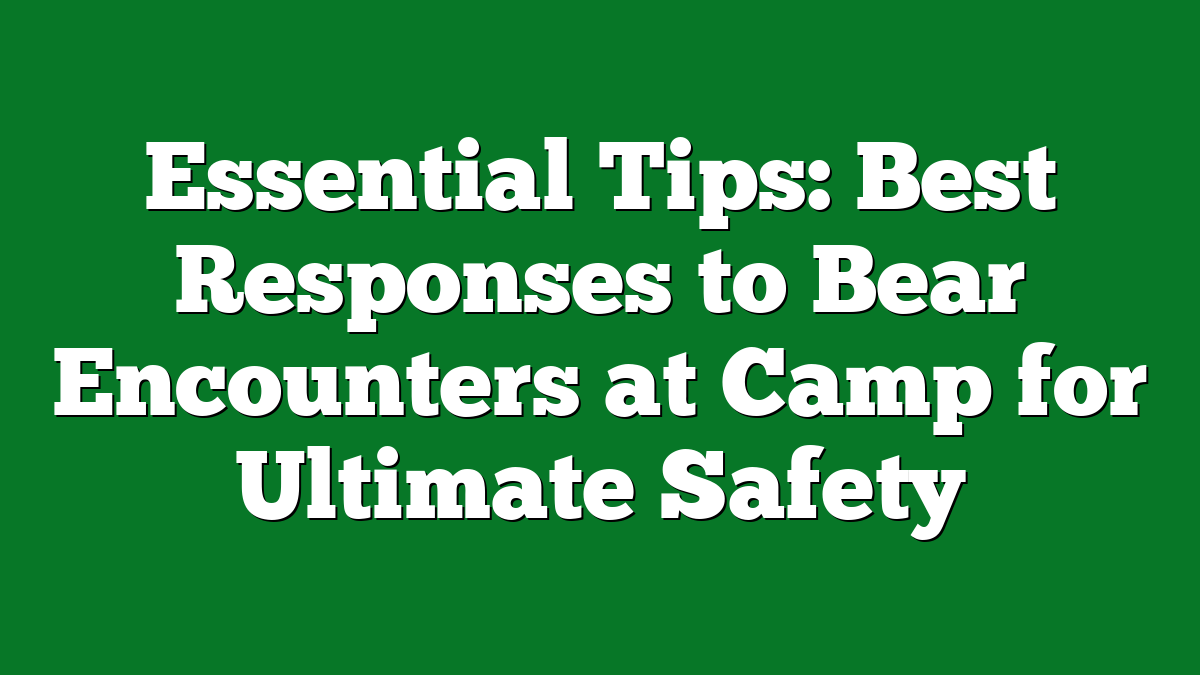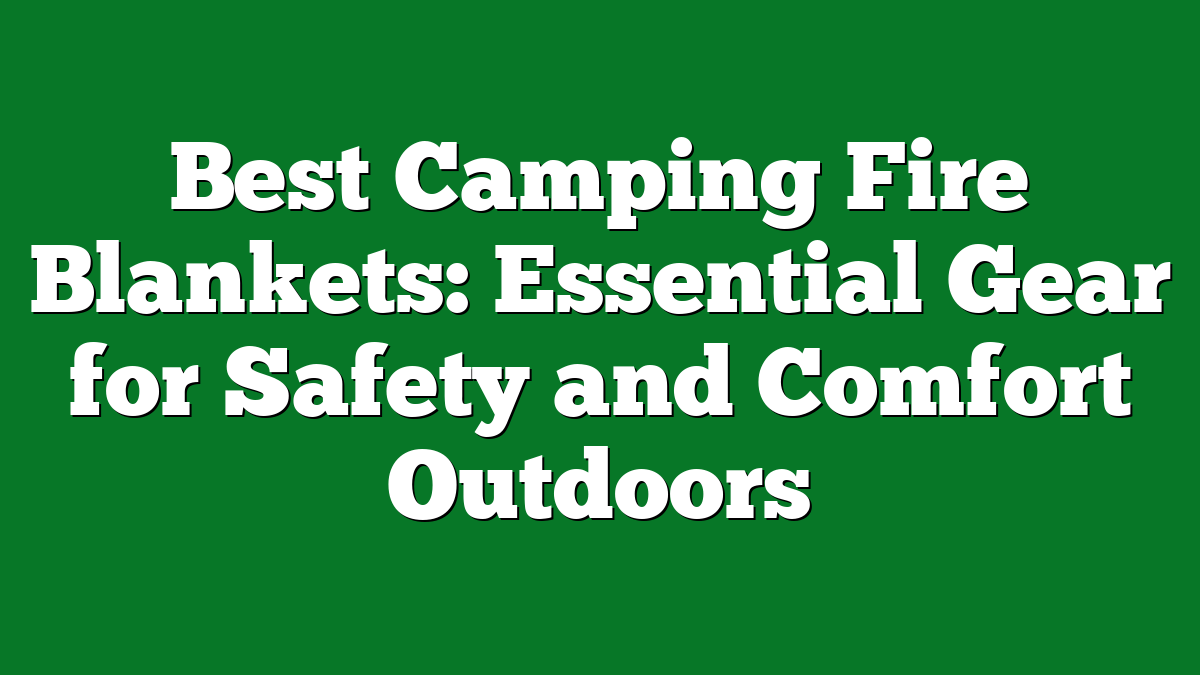Camping in the great outdoors is one of life’s simplest pleasures, but it comes with its own set of challenges. One of the most daunting experiences can be encountering a bear. I’ve had my fair share of close calls, and trust me, knowing how to respond can make all the difference.
In this article, I’ll share some of the best responses to bear encounters that I’ve learned over the years. Whether you’re a seasoned camper or just starting out, these tips will help you stay calm and safe while enjoying nature. Let’s dive into how to handle these magnificent creatures with respect and caution.
Overview of Bear Encounters
Bear encounters can occur during camping trips, especially in areas where bears are common. Understanding bear behavior is key to preventing dangerous situations. Black bears, for instance, are usually less aggressive and often flee when they sense humans. Grizzly bears, however, can be more unpredictable and may react defensively if they feel threatened or if cubs are nearby.
Preparation plays a crucial role in bear safety. Storing food and trash properly reduces attractants at campsites, minimizing the chance of an encounter. Utilizing bear-proof containers or hanging food at least 10 feet off the ground and 4 feet from tree trunks can deter curious bears.
Knowing how to react also matters. Staying calm during an encounter can help maintain safety. I’ve learned that making noise while hiking, like singing or chatting, also alerts bears to my presence, giving them time to avoid me. If confronted by a bear, standing tall and speaking in a firm voice helps convey I’m not a threat.
In situations where a bear approaches, backing away slowly and avoiding direct eye contact is essential. In rare cases of defensive bears, playing dead often works for grizzly encounters, while making myself appear larger for black bears tends to deter them.
Awareness of one’s surroundings and practicing safe camping methods make a significant difference. These strategies not only protect me but help ensure a peaceful coexistence with bears in their natural habitats.
Understanding Bear Behavior
Understanding bear behavior is key to staying safe while camping. Spending time outdoors, I’ve encountered various bear species and have learned how their behaviors can inform our actions.
Types of Bears
- Black Bears
Black bears are typically smaller, weighing between 100 to 600 pounds. They tend to avoid humans and are generally less aggressive. However, they can become defensive if they perceive a threat, especially if cubs are nearby.
- Grizzly Bears
Grizzly bears are larger, often weighing between 400 to 1,500 pounds. They are more unpredictable and may act aggressively if surprised. Their protective nature, particularly when foraging or with cubs, necessitates caution.
- Polar Bears
Polar bears, primarily found in the Arctic, weigh between 900 to 1,600 pounds. Unlike other bears, they may show predatory behavior toward humans, so encountering one requires extreme caution.
Common Behaviors of Bears
- Foraging
Bears spend significant time foraging for food. They can smell food from miles away, so securing your campsite is essential to avoid attracting them.
- Marking Territory
Bears often mark their territory by scratching trees or piling up rocks. If you notice these signs, exercise increased caution, as you may be near a bear’s home range.
- Climbing
While black bears are excellent climbers, grizzlies sometimes climb too, though less frequently. Always be aware of nearby trees and bear presence while hiking.
- Demeanor Change
A bear’s demeanor can change when sensing a threat. They may puff their fur, make vocalizations, or huff. Recognizing these behaviors is vital for gauging how to react during an encounter.
Familiarizing myself with each bear’s particular traits and behaviors has helped me navigate the wilderness with more confidence and safety.
Preparation Before a Camping Trip
Before heading out into the wild, preparing properly minimizes the risk of bear encounters. Knowledge and the right equipment lay the groundwork for a safer experience.
Bear-Proof Gear and Supplies
I always equip myself with bear-proof gear to reduce risks. A bear canister stores food securely, keeping it out of reach. Additionally, bear-resistant coolers prevent bears from accessing perishable items. I’ve found that using bear spray, which deters a bear if it approaches too closely, enhances my confidence while camping. It’s essential to keep gear like these in an easily accessible spot during my trip.
Safe Food Storage Techniques
Safe food storage significantly decreases attractants. I hang food and trash at least 10 feet off the ground and 4 feet from the tree trunk, ensuring it’s out of a bear’s reach. Additionally, I keep food in airtight containers that reduce odors. Using a designated cooking area away from my sleeping space limits scent trails. I store all trash in sealed bags, bringing it back home instead of leaving it at the campsite. Following these techniques helps me enjoy my time in nature without unnecessary worries about bears.
Best Responses to Bear Encounters
Bear encounters can be intimidating, but knowing the correct responses makes all the difference. Here’s how to navigate these situations safely and effectively.
Keeping Calm and Assessing the Situation
Keeping calm during a bear encounter is crucial. If I spot a bear, the first step involves taking a deep breath and assessing the situation. I observe the bear’s behavior to determine if it’s aware of my presence or if it’s simply foraging. If the bear seems agitated or curious, I stand still, avoid direct eye contact, and prepare to move slowly. Understanding whether the bear is defensive or curious shapes my response significantly.
Making Your Presence Known
Making my presence known without startling the bear is essential. I talk in a calm, firm voice while waving my arms slowly. I let the bear know I’m human and not a threat. If the bear is nearby, I may back away slowly while continuing to speak. Most bears want to avoid humans, so my goal is to discourage any close approach without appearing aggressive. Making noise while hiking also helps, as the sound of my voice or clattering gear can alert bears to my presence before an encounter occurs.
Asserting Yourself: The Use of Bear Spray
Using bear spray can be a lifesaver during an encounter. I carry it in an easily accessible spot, like a holster clipped to my belt. If a bear approaches aggressively, I aim the spray at its face, releasing it when the bear is within 30 feet. Bear spray contains capsaicin, which momentarily blinds and irritates the bear without causing long-term harm. My focus is on creating a barrier between myself and the bear while giving it the chance to retreat.
By knowing these methods, I feel more prepared and confident when adventuring in bear territory.
Post-Encounter Safety Tips
After a bear encounter, it’s vital to stay vigilant and follow specific safety protocols to ensure your well-being.
What to Do After an Encounter
I prioritize assessing my surroundings immediately after an encounter. If the bear has moved away, I slowly backtrack the way I came, keeping noise levels low to avoid startling any other wildlife. I avoid sudden movements or loud noises; a calm demeanor helps maintain safety. It’s crucial to take note of the bear’s direction and any signs of its presence, like tracks or scat. If I’ve encountered a bear during a hike, I wait a while before continuing my journey. This period allows the bear to move farther away and reduces the risk of running into it again.
After I feel certain the bear’s gone, I inspect my gear. Ensuring food and supplies are secured helps prevent attracting bears back to my campsite. In addition, I may take the opportunity to reevaluate my methods of storage and assess whether I need more bear-proof solutions. I’d rather be overly cautious than face another encounter.
Reporting the Encounter
Reporting the encounter helps not just me but also fellow campers, park rangers, and wildlife officials. I search for a ranger station or use park communication methods to inform authorities about the sighting. In my report, I include details like the bear’s size, color, behavior, and exact location. Such information aids in tracking bear movements and enhances safety for everyone in the area. By sharing this information, I contribute to the collective knowledge that helps manage wildlife encounters effectively.
Conclusion
Camping in bear country can be an incredible experience filled with adventure and beauty. By being prepared and knowing how to respond to bear encounters, I can enjoy the great outdoors with confidence. Understanding bear behavior and practicing safety measures helps keep both me and the bears safe.
I’ll always remember to stay calm and assess the situation if I ever find myself face-to-face with a bear. Reporting encounters and sharing experiences with fellow campers can also make a difference in keeping our wilderness safe for everyone. With the right knowledge and precautions, I can make the most of my camping trips while respecting the wildlife around me. Happy camping!











